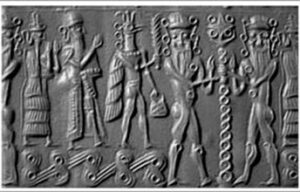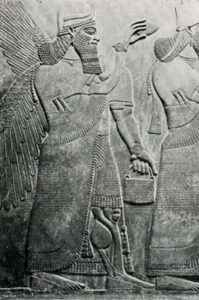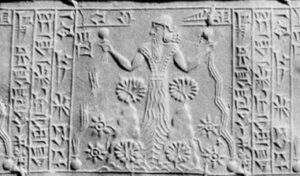The Symbologist
Some time ago there was a viral uproar about this topic. Theories about the meaning of the ‘handbag’ in ancient images range from the idea that it proves time travel – how else could a god from long ago have a designer bag? – to its use for carrying gold while hanging from an ancient Egyptian helicopter.
In order to decode symbols within images, one must first take into consideration their context: when, where, what, who, and how. Symbolic language uses patterns and so one must also be in the habit of counting dots, lines, angles, and other repeated shapes. Images of the handbag appear in many cultures. They are all carried by gods or kings. One must understand the structure of ‘language’ at the time a symbol was created to accurately decode its meaning. Enzmann was a world authority on the subject.
In the book Ice Age Language: Translations, Grammar, and Vocabulary (Enzmann, pub: WKS 2013) Enzmann explains the pictorial language used since the ice ages and how this language works. Cardinal images (nouns) are fundamental to ‘reading’ inscriptions and images; if it is a picture of a duck, it is about a duck – how and when to hunt one, what parts of it are useful and for what, and how to use them. All this information is inscribed on bone, stone, or ivory, preserved for the succeeding generations.
Link lines connect symbols that are relevant to each other, lead lines direct the flow of information. It was a grammar of sorts, creating paragraphs of information with pictures. This picture-language was used for tens of thousands of years and is still evident in modern languages such as Chinese. So, Enzmann is a great source of information when looking at ancient symbols.
Geometric shapes were used to depict concepts, nouns, and ideas. Most of our contemporary symbols evolved from those used in prehistory for astronomical, agricultural, and navigational notations.
To decode what part of an image might mean, it is necessary to have a general idea of what the rest of the image is telling you, and to do that, you must know the culture and when the image was made. Enzmann’s timelines are a precious resource.
The ‘Handbag of the Gods’ is a symbol found in sculptures and imaged as part of emblems and reliefs. They are always connected with kings, gods, or leaders. According to Enzmann, this shape is used to convey a standard weight, just as the megalithic yard was a standard measurement used to build the megalithic observatories and is imaged with kings and gods.
The symbol for this standard of measurement is the rod and cord, found on many ancient images, and again, it is always associated with leadership, power, kings, and gods.

The rod (blue) and cord (red) of ancient and prehistoric kings, queens, and gods
One must consider the applications of the concept of weight. Ounces and pounds, or kilograms, depending on where the image appears (one must always consider where a symbol is being used), are one idea of weight.
But there is also the weight of the law. The weight of tribute. The weight of obligation. The weight of responsibility. This ‘handbag’ represents all of these concepts; which one is prevalent depends upon the ‘paragraph’ it is in, just as words like ‘ruler’ do. Whether it refers to a king or a straight edge depends upon context.
Enzmann traces the ‘handbag’ to ancient Egypt, where the Remen (rod and cord) was a symbol for standard length. The Egyptians used the handbag as a symbol for standard volume and weight. It is discovered in older images such as Gobekli Tepi, created by a culture the Zep Tepi Egyptians evolved from.
The Handbag of the Gods is found around the globe because the culture that used the symbol migrated and settled around the globe.
In Gobekli Tepe (image 1) one inscription shows three handbags, which Enzmann translates as fractions of weight.
1 
Image 2 shows four characters. From left to right: Time (patterns and angles), Weight (the handbag), Length (with the rod and cord), and Area (the ashera pole for astronomical reading).
2 
Image 3 is an example of weight as the law, the weight of taxes on you – which implies the weight of the law the king or leader must uphold.
3 
Another symbol that is consistently used, much of the time in emblems where the handbag is evident, is the flower pattern called a ‘watch’. You can see one here on the wrist of the hand holding the handbag.
Again, to some persons this is confirmation of advanced alien technology or time travel. However, it is a watch of sorts, a calendric which shows specific patterns of the solar and lunar year and is often shown separately from the ‘watchband’.

These designs depict a certain astronomical time, a record of when during the year the King is obliged to collect taxes – which at the time were grain, gems, and other produce. They need to be weighed, and the handbag was the balancing weight.
Consider mechanical scales. An object is placed on one side on a plate, then a weight is placed on the other side. Either the weight or the object is manipulated until they balance the scale.
The handbag is a weight, with a handle to make it easy to pick up. In most handbag reliefs there are the watches, to depict what time of year these taxes are to be weighed out. They also depict other yearly (astronomically timed) events as shown in the next image.
4
Image 4 shows us four such ‘watches’ and in them, much seasonal information. In his right hand (your left) a symbol that indicates dry-season rod-and-cord land surveys.
In his left hand (your right) we see semi-monsoonal valley floods. The flower pattern circles, left to right, show us a four-season calendric, and reading the rims tells when taxes and percentages of crops are to be paid.
![]()




